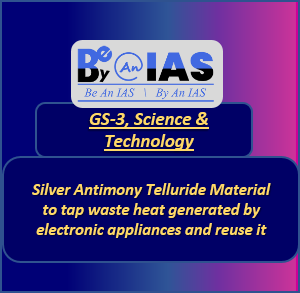CURRENT AFFAIRS
Get the most updated and recent current affair content on Padhaikaro.com
Silver Antimony Telluride Material to tap waste heat generated by electronic appliances and reuse it
- Be N By IAS, Delhi
- 20, Feb 2021

For: GS-3: Science & Technology
CONTEXT:
- Bengaluru-based scientists have developed a new material that can help in tapping waste heat produced by all kinds of domestic and industrial appliances, and use it to accomplish other useful work.
- The heat from the laptop, for example, can be used to charge a mobile phone. Or, that from the phone can be used to charge a small watch.
ENERGY CONVERSION:
- Industrial processes and power plants produce ample amount of waste heat that can be utilised to do significant amounts of work.
- The key is to find an energy conversion process that can convert heat into the more convenient electrical energy which can then be deployed to drive other machines or processes.
- Bengaluru-based Jawaharlal Nehru Centre for Advanced Scientific Research claim to have found a new material, Silver Antimony Telluride, that can facilitate this energy conversion.
- Energy conversion, in general, is not a very efficient process. Only a small fraction of energy that is used is actually productive. The rest of it becomes waste, often getting released as heat.
- For example, when we burn fuel in the automobile engines, only about 30 per cent of the total energy content is used to drive the vehicle.
SIGNIFICANCE:
- This waste heat can be tapped, and further converted into electrical energy, but this process too is highly inefficient.
- Typically, not more than 15 to 20 % of the waste heat can be utilised.
WORKING PRINCIPLE/THERMO-ELECTRIC EFFECT:

- If two ends of an electrically-conducting material, like a metal, are maintained at different temperatures, current flows from the hot end towards the cold one.
- It is rather simple and known to scientists for more than 200 years.
- This phenomenon makes it possible to generate heat from the waste.
- Problem in Transfer of Energy: in facilitating this transfer of energy, however, is the fact that most materials that conduct electricity, also happen to be good conductors of heat. That means that there would not be any significant temperature difference between the two ends of the material for very long.
- Traditional thermo-electric effect: It has been demonstrated — and utilised — by using two different metals joined together, and by mechanically maintaining two different temperatures at the ends.
- But such materials do not offer efficient or economical solutions.
- Needed: The quest has been to find a material that is a good conductor of electricity but a bad conductor of heat.
MATERIALS USED:
- Lead Telluride: It also show this property. But because lead has very adverse environmental impacts, it was important to look for lead-free materials.
- Silver Copper Telluride: A compound of Silver, Copper and Tellurium, called Silver Copper Telluride, that showed this property (good conductor of electricity but a bad conductor of heat).
- The Silver Copper Telluride offered lesser efficiency than Lead Telluride.
- Silver Antimony Telluride: It is more efficient at energy conversion.
- Electrical conductivity has to be high, while heat conductivity must be low.
- Atomic ordering: We have doped the material with a dopant that brings in a very high degree of order in its atoms. And, we are able to control both the electrical conductivity, as well as heat conductivity of the material.
- This concept of atomic ordering can actually be applied to a variety of other materials as well, to exploit the benefits of thermo-electric effect.
POTENTIAL APPLICATIONS:
- It is of course quite useful in large industrial set-ups. And, we are waiting for more industry partners to check this out. But there are other places where it can be deployed.
- We are currently working on an international projects that is exploring the possibility of tapping the heat from traditional cooking chulhas to run some electrical appliances in rural households,”
SOURCE: Indian Express
MCQs:
Q. Consider the following statements regarding thermo-electric effect.
- If two ends of an electrically-conducting material, like a metal, are maintained at different temperatures, current flows from the cold end towards the hot one.
- In material ‘Silver Antimony Telluride’, electrical conductivity is high, while heat conductivity is low.
Which of the above statements is/are correct?
- a) 1 Only
- b) 2 Only
- c) Both 1 and 2
- d) Neither 1 nor 2
ANS: B